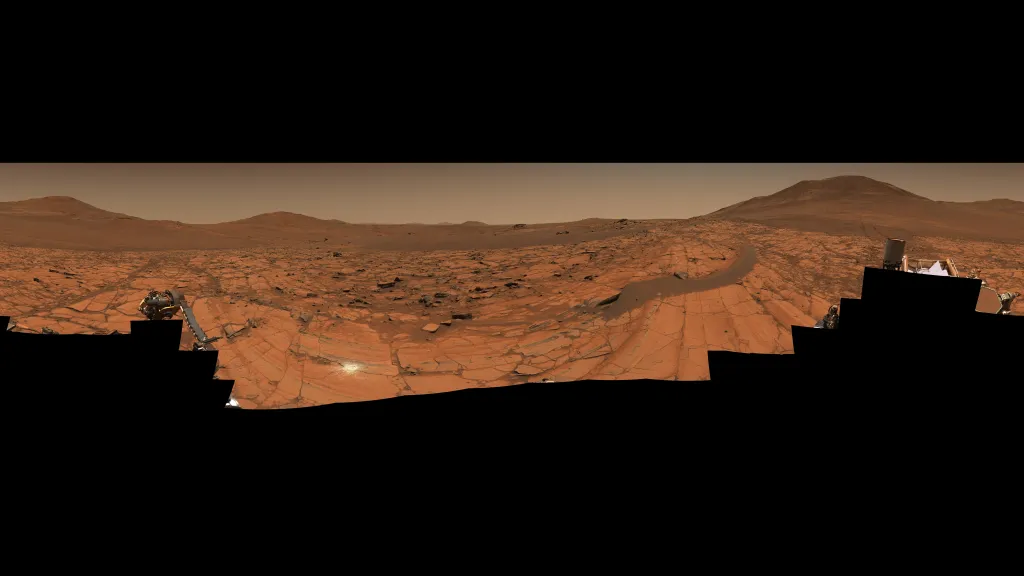NASA's Perseverance captures the rarest image of the Martian sky to date: it looks a lot like Earth's

NASA's Perseverance mission has once again amazed the world with one of the clearest and most detailed views it has captured since arriving on Mars. The rover's imaging team took advantage of clear skies to record, on May 26, 2025, a high-resolution mosaic of 96 photographs taken at a point on the red planet known as Falbreen. The image reveals geological textures and nuances ranging from nearby rock formations to hills located more than 65 kilometers away.
The panorama, generated with the Mastcam-Z camera, shows two versions: a natural-color version, where the sky has its characteristic reddish hue, and a color-enhanced version, where it takes on a deceptive blue that accentuates the contrast with the terrain. “The relatively dust-free skies provide a clear view of the surrounding landscape. In this mosaic, we enhanced the color contrast to highlight the differences between the terrain and the sky,” explained Jim Bell, Mastcam-Z principal investigator at Arizona State University.

The image could include the oldest rocks explored by the mission in Jezero Crater. Photo: NASA
Among the details that have caught the scientists' attention is a large rock that appears to rest on a crescent-shaped sand ripple, located just over four meters from the vehicle. This is a "floating rock," so named because it likely formed elsewhere and was transported to its current location. Its origin remains a mystery: it may have arrived by a landslide, by the drag of water, or by the force of the wind, and it is believed to have been there since before the formation of the dune that supports it.
A small white circle can also be seen in the central section of the image: this is the 43rd abrasion scar made by Perseverance since landing in February 2021. Measuring five centimeters in diameter, this mark is the result of using its drill to remove the surface layer of a rock and observe what lies beneath. This procedure allows the rover to decide whether or not to take a sample for storage in the titanium tubes that are part of the Martian materials collection mission.
From Earth, scientists analyze a "floating rock" and an abrupt change in terrain. Photo: NASA
This abrasion work was carried out on May 22, and two days later, the rover performed a detailed analysis using the instruments on its robotic arm. Falbreen is of particular interest: scientists suspect it may contain some of the oldest rocks examined by the mission, even predating the formation of Jezero Crater itself.
The image also reveals the rover's wheel tracks, which wind to the right before disappearing into the distance, heading toward a previously surveyed site called Kenmore. Halfway up the mosaic, a color change can be seen in the terrain: the contact line between two different geological units. The lighter rocks, located near the rover, contain olivine, while the darker ones in the background are clayey and much older.
Acting NASA Administrator Sean Duffy emphasized that images like Falbreen's are an inspiration for future human missions: "Our determined commitment to human space exploration will take us back to the Moon. Stunning views like this are just a taste of what we'll see with our own eyes. NASA's groundbreaking missions, beginning with Artemis, will propel us forward on our unstoppable path to the Martian surface."

The Perseverance rover has found several rocks since its arrival on Mars. Photo: iStock
The Perseverance rover, developed by NASA's Jet Propulsion Laboratory (JPL) in collaboration with Caltech, is part of the agency's Mars exploration program. Its mission: to search for signs of past life, characterize the planet's geology and climate, and pave the way for the arrival of astronauts. With panoramas like this, Mars ceases to be a distant dot in the sky and becomes a tangible landscape, inviting us to imagine the day a human being will contemplate it without the mediation of a camera.
Environment and Health Journalist
eltiempo





